-
试验设计
普通类 -
- 支持
- 批判
- 提问
- 解释
- 补充
- 删除
-
-
Study of Widow Spiders
资源介绍/ Introduction
The author choose to teach students five types pf widow spiders as cultural topic to inform that some of spiders are dangerous and species may bite if they feel threatened.
一、学习目标/ learning objectives
通过本讲内容的学习,需要达成以下学习目标/ through the study of this subject, you need to achieve the following learning objectives:
1- To understand and classify the characteristics and habits of four spiders.2- To organize the charactersitics and habits of spiders to display the main ideas between them.
3- To create a conceptual knowledge framework to connect ideas and sub-ideas between spiders.
-
适用对象
基础教育- 五年及
-
学习内容
SpeciesThere are five species of widow spiders in United States; Red widow, Latrodectus bishopi;Brown widow, L. geometricus; Western black widow, L. hesperus; Southern black widow, L. mactans, and Northern black widow, L. variolus. Both are characterized by a similar body shape, reclusive habit, and irregular cobwebsGeneral identificationLike all spiders, the widow spiders (Red widow, Brown widow, Western black widow, Southern black widow and Northern black widow) have two main body parts, the cephalothorax (the body part to which the legs attach) and abdomen. The cephalothorax bears the head and legs. The abdomen is much larger than the cephalothorax. The spinnerets, or silk and web making appendages, are attached to the rear end of the abdomen. On widow spiders, the spinnerets look like a cluster of small cones. See the following picture. The Western widow is found in west of the Mississippi. The Red and brown widows are found mainly in Florida, but the Brown widow has been found as far west as Texas. In Virginia, the Northern and Southern Black widows are the species typically found. All five widow Spiders prefer to live in undisturbed areas, such as rock or woodpiles, occupy garages, storage sheds, or crawlspaces, particularly in temperate regions around the world. The chief danger from widow spiders lies in their venom. Widow spider venom is one of the few medically significant venom.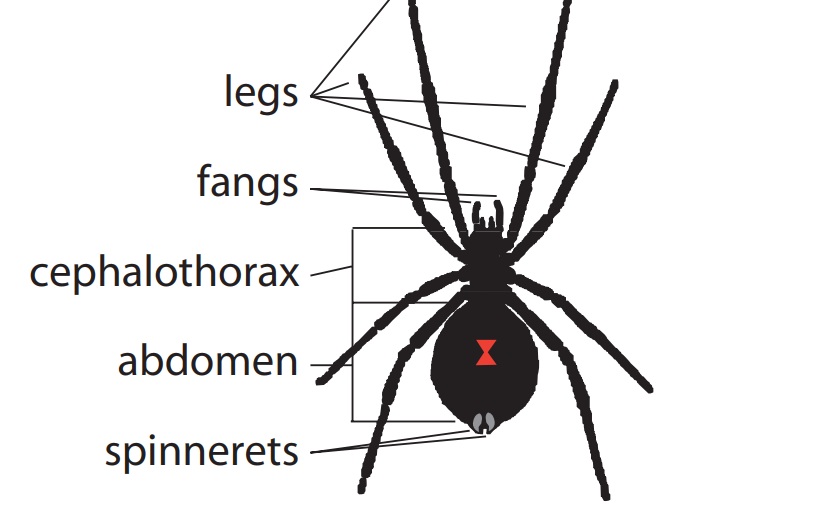 1. Red widow SpiderIdentificationThe red widow spider has a reddish-orange head, thorax and legs with a black abdomen. The top of the abdomen usually has a row of red spots with yellow borders. This spider lacks a complete hourglass on the underside of the abdomen and instead usually has one or two small red marks. Each egg sac contains approximately 250 eggs.The average size of mature female is approximately 0.5 inch, with a leg span of 1.5 to 2 inches. Mature males are much smaller - approximately 1/3 the size of the female. Adult females of this species specialize in capturing flying insects. Females may live for two to three years whereas males only live for about six or seven months.
1. Red widow SpiderIdentificationThe red widow spider has a reddish-orange head, thorax and legs with a black abdomen. The top of the abdomen usually has a row of red spots with yellow borders. This spider lacks a complete hourglass on the underside of the abdomen and instead usually has one or two small red marks. Each egg sac contains approximately 250 eggs.The average size of mature female is approximately 0.5 inch, with a leg span of 1.5 to 2 inches. Mature males are much smaller - approximately 1/3 the size of the female. Adult females of this species specialize in capturing flying insects. Females may live for two to three years whereas males only live for about six or seven months.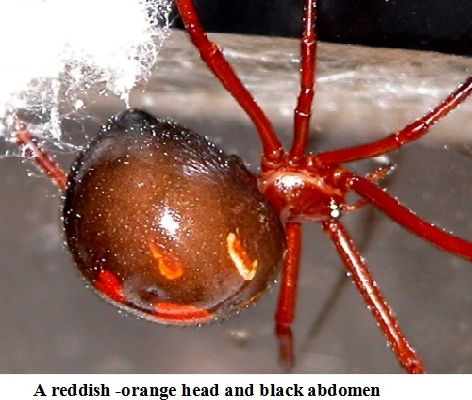 2. Brown widowIdentificationThe brown widow is highly variable in color. It may be almost white to almost black. Typically, it is a light to medium brown, with an orange-to-yellow hourglass marking on the underside of the abdomen; the coloration of the hourglass often is a good indication of this species. The sac is so characteristic that it can be used to verify the presence of brown widows. Brown widows produce about 130 eggs per each egg sac. Female siz; about 12-16 mm (> 0.5 inch) long (body length only, not including legs) and male is much smaller, 6-8 mm (about half the body length of a female) but with longer legs. The Typical foods is insects, but has been observed killing small toads that have gotten caught in its web. Females can live up to 3 years, while the males only live from 6 months to 1 year.
2. Brown widowIdentificationThe brown widow is highly variable in color. It may be almost white to almost black. Typically, it is a light to medium brown, with an orange-to-yellow hourglass marking on the underside of the abdomen; the coloration of the hourglass often is a good indication of this species. The sac is so characteristic that it can be used to verify the presence of brown widows. Brown widows produce about 130 eggs per each egg sac. Female siz; about 12-16 mm (> 0.5 inch) long (body length only, not including legs) and male is much smaller, 6-8 mm (about half the body length of a female) but with longer legs. The Typical foods is insects, but has been observed killing small toads that have gotten caught in its web. Females can live up to 3 years, while the males only live from 6 months to 1 year.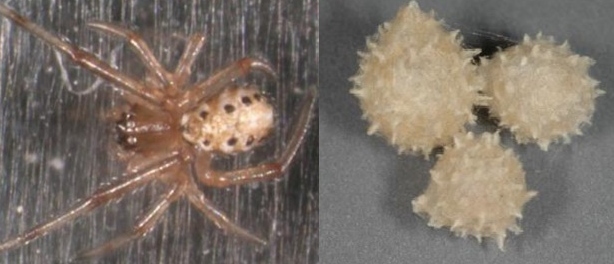
3. Western black widow
IdentificationFemales have a complete hourglass marking on the underside of the abdomen, which is usually completely black except for a small reddish spot near the tip. Males of the western black widow have three diagonal pale stripes on each side of the abdomen and are usually light brown. Mature male western black widows do not drastically change their body coloration and resemble juveniles of both sexes. Yet, like the female, the male’s hourglass becomes brighter in color, usually yellow or orange.The margins of the sac are well defined (as opposed to some spider egg sacs, which look like fluffy cotton balls, making it difficult to determine exactly where the egg sac starts). A female western black widow typically lays about 300 eggs per sac.Females size; 14-16 mm (1/2 inch) body size (not including legs) ,Males size; approximately half the size of the female (7-8 mm, ~1/3 inch; not including legs). Food includes beetles, cockroaches, and flies. Western widows kill by means of very small, hollow fangs through which they inject a poisionous venom into their prey. After emerging from the egg sac, males mature faster than females, in just 2–5 months they die after about a month to two months. Females mature usually live up to a year and a half.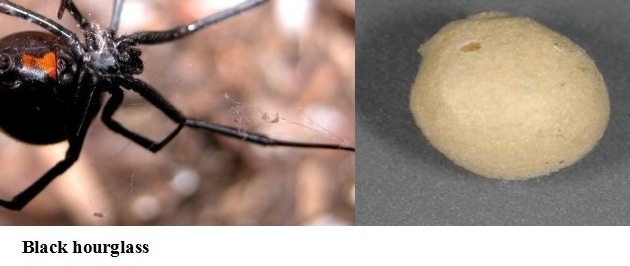 4. Southern black widowIdentificationThe adult female black widow spider has a glossy jet black color all over, including body and legs. The only red marks are the bright red hourglass mark on the underside of the abdomen, and a red spot just behind and above the spinnerets. The hourglass marking consists of two connected red triangles on the underside. The male’s legs are larger than the female’s and each joint is orange brown in the middle and black on the ends. On the sides of the male’s abdomen there are four pairs of red and white stripes. The female sacs is typically contain around 220 eggs, which are approximately 0.8 mm in diameter. Adult Female and male sizes, approximately 8-13 mm (~1/2 inch) in body length.While adult Male Approximately half the size of the female, around 4-6 mm (1/4 inch) in body length. They typically prey on a variety of insects, but occasionally they do feed upon wood lice, diplopods, chilopods and other arachnids. It takes two to four months for black widow spiders to mature. The female live on for 180 days after maturing, while a male only lives on for another 90 days.
4. Southern black widowIdentificationThe adult female black widow spider has a glossy jet black color all over, including body and legs. The only red marks are the bright red hourglass mark on the underside of the abdomen, and a red spot just behind and above the spinnerets. The hourglass marking consists of two connected red triangles on the underside. The male’s legs are larger than the female’s and each joint is orange brown in the middle and black on the ends. On the sides of the male’s abdomen there are four pairs of red and white stripes. The female sacs is typically contain around 220 eggs, which are approximately 0.8 mm in diameter. Adult Female and male sizes, approximately 8-13 mm (~1/2 inch) in body length.While adult Male Approximately half the size of the female, around 4-6 mm (1/4 inch) in body length. They typically prey on a variety of insects, but occasionally they do feed upon wood lice, diplopods, chilopods and other arachnids. It takes two to four months for black widow spiders to mature. The female live on for 180 days after maturing, while a male only lives on for another 90 days.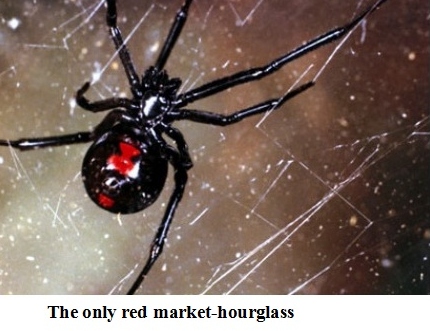 5. Northern Black WidowIdentificationFemale Northen Black Widow often can be distinguished from the female Southern Black Widow by the type of hourglass marking on the ventral portion of the abdomen. For the Northern Black Widow, the hourglass is distinct, but is broken,whereas the southern Blak hourglass is complete and typically there is a row of red spots down the middle of the back and possibly some diagonal whitish bands on each side. Northen Black Widow is similar to the Southern Black Widow in general behaviors. But in particular is larger than the southern black widow spider. Adult Female: approximately 9-11 mm (just under 1/2 inch) in body length (not including legs), adult Male: approximately half the size of the female, around 4-5 mm (just under 1/4 inch) in body length (not including legs). A female black widow spider can produce four to nine egg sacs in one summer, each containing about 100-400 eggs. This type of spiders prefers to live in undisturbed areas, such as rock or woodpiles, occupy garages, storage sheds, or crawlspaces, particularly in temperate regions and sometime in cold places. Black widow can be identified by their round, shiny black bodies and the distinctive red hourglass marking on their underside.
5. Northern Black WidowIdentificationFemale Northen Black Widow often can be distinguished from the female Southern Black Widow by the type of hourglass marking on the ventral portion of the abdomen. For the Northern Black Widow, the hourglass is distinct, but is broken,whereas the southern Blak hourglass is complete and typically there is a row of red spots down the middle of the back and possibly some diagonal whitish bands on each side. Northen Black Widow is similar to the Southern Black Widow in general behaviors. But in particular is larger than the southern black widow spider. Adult Female: approximately 9-11 mm (just under 1/2 inch) in body length (not including legs), adult Male: approximately half the size of the female, around 4-5 mm (just under 1/4 inch) in body length (not including legs). A female black widow spider can produce four to nine egg sacs in one summer, each containing about 100-400 eggs. This type of spiders prefers to live in undisturbed areas, such as rock or woodpiles, occupy garages, storage sheds, or crawlspaces, particularly in temperate regions and sometime in cold places. Black widow can be identified by their round, shiny black bodies and the distinctive red hourglass marking on their underside.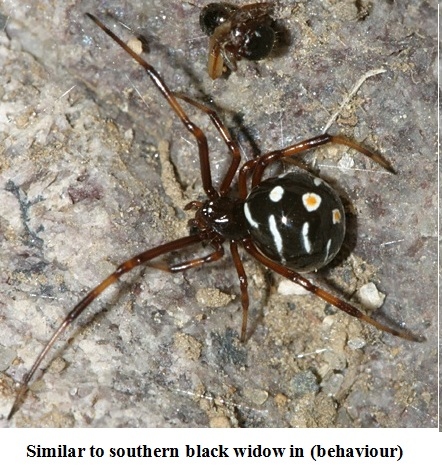
-
视频- Spider habitat,lives and some characteristics
-
Activity 1
-
Activity 2
活动类型:讨论交流活动名称:Activity 2活动描述:How do you distinguish between five widow spiders in hourglass styles.-
Activity 3
活动类型:概念图活动名称:Activity 3活动描述:Create a conceptual map to relate the ideas and sub-ideas between five spiders. -
-
- 标签:
-
加入的知识群:


学习元评论 (0条)
聪明如你,不妨在这 发表你的看法与心得 ~